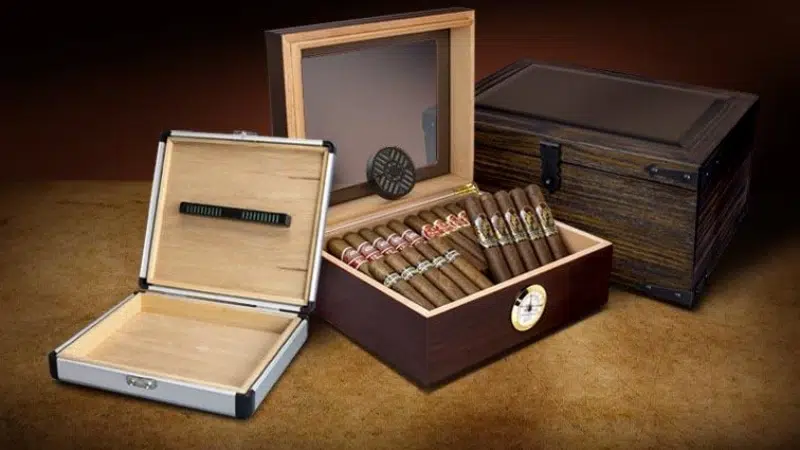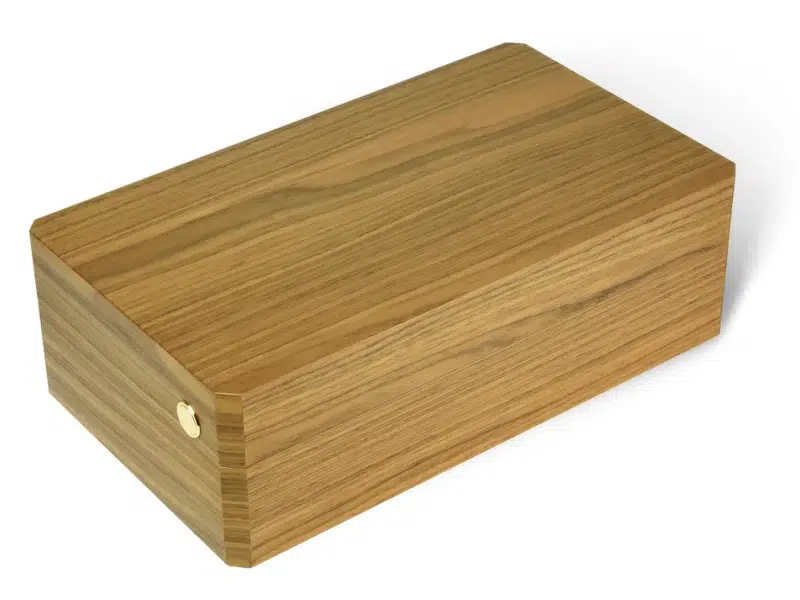
Una scatola di sigari mal sigillata può rovinare i vostri sigari, indipendentemente dalla bellezza dell'artigianato.
Per verificare l'ermeticità di una scatola di sigari di fascia alta, utilizzate semplici metodi visivi e tattili, controlli della ritenzione di umidità e strumenti di precisione per garantire una tenuta duratura e affidabile.
L'ermeticità è più di un lusso: è una necessità funzionale. Anche la scatola di sigari più elegante perde il suo valore se non riesce a mantenere un'umidità costante. Vediamo come io e molti altri operatori del settore testiamo le prestazioni dell'ermeticità sia nei campioni personalizzati che nelle serie complete.
Quali semplici metodi possono verificare la tenuta senza attrezzature speciali?
Non è necessario l'equipaggiamento da laboratorio per avere una prima solida impressione della qualità delle guarnizioni.
Provate queste tecniche pratiche:
- Test di caduta del coperchio1: Lasciare cadere delicatamente il coperchio da circa 2-3 cm e ascoltare. A sibilo sommesso o arresto ammortizzato indica una buona tenuta.
- Test di pressione manuale2: Premere delicatamente il coperchio chiuso e sentire la pressione di rimbalzo. Se l'aria torna indietro, è un ottimo segno.
- Resistenza all'apertura3: Una chiusura ermetica spesso provoca una leggera resistenza quando si solleva per la prima volta il coperchio. Se si apre troppo facilmente, è possibile che ci sia una perdita.
Questi metodi non forniscono misure esatte, ma sono veloci e sorprendentemente efficaci per valutare l'artigianato.
Come può il "test su carta4" o "test della luce5" aiuto rilevare le perdite d'aria6 in giunti di legno?
Entrambi sono poco tecnologici e molto utili.
- Test su carta: Chiudere il coperchio con un foglio di carta sottile. Provate a tirare fuori la carta: se scivola facilmente, la tenuta non è perfetta. Se invece resiste, è probabile che la tenuta sia solida.
- Test della luce: In una stanza buia, posizionare una piccola torcia all'interno della scatola e chiudere il coperchio. Qualsiasi luce visibile che fuoriesca dalle giunture, dagli angoli o dalla zona delle cerniere è un indicatore di perdita.
Sono particolarmente utili durante i primi controlli dei campioni o quando si confrontano i modelli di diversi produttori.
Che ruolo hanno le cerniere, le chiusure e l'allineamento del coperchio nel mantenere l'ermeticità?
Anche con giunti perfetti, la ferramenta può rovinare la tenuta se non è installata correttamente.
Aree chiave da ispezionare:
- Cerniere7: Deve essere a filo, senza movimenti laterali. Cerniere allentate = coperchio che si sposta = guarnizione rotta.
- Ganci8: Devono chiudersi in modo aderente senza forzare. Le chiusure magnetiche devono "scattare" in posizione con una leggera resistenza.
- Allineamento del coperchio9: I bordi devono essere allineati in modo uniforme. Anche una leggera deformazione o un disallineamento possono consentire l'ingresso di aria.
Una scatola di sigari di fascia alta è ermetica solo quanto il suo raccordo più debole: ogni componente è importante.
Può test di ritenzione dell'umidità10 riflettono accuratamente le prestazioni di tenuta di una scatola?
Assolutamente sì, e simulano l'uso reale.
Ecco come eseguire una versione di base:
- Posizionare un igrometro digitale calibrato11 e Confezione Boveda12 (o un umidificatore simile) all'interno della scatola.
- Sigillare la scatola e conservarla a temperatura ambiente per 48-72 ore.
- Tenere traccia delle letture dell'umidità. Una buona tenuta dovrebbe mantenere un livello di RH stabile (circa 65-70%) con fluttuazioni minime.
Un calo o un aumento improvviso spesso significa che c'è una perdita d'aria. Per ottenere risultati ottimali, confrontarsi con una scatola di controllo nota per la sua ermeticità.
In che modo il tipo di legno e la qualità della costruzione influiscono sulla capacità di tenuta all'aria a lungo termine?
Il legno massiccio è bello, ma si muove.
- Cedro spagnolo13: Ottimo per il controllo dell'umidità, ma può deformarsi leggermente se non viene stagionato o asciugato correttamente.
- Compensato + impiallacciatura14: Spesso più stabile, soprattutto per i pannelli o i coperchi più grandi.
- Falegnameria15: Gli angoli smussati, i giunti a pettine e le strutture a incastro maschio/femmina garantiscono una migliore tenuta all'aria a lungo termine rispetto ai semplici giunti di testa.
Inoltre, verificare che non vi siano fessure nel rivestimento interno o pannelli allentati che potrebbero spostarsi nel tempo e compromettere la tenuta.
Quali sono gli strumenti o le tecniche professionali che i produttori possono utilizzare per effettuare test di precisione sull'ermeticità?
Quando si produce in scala, la precisione è importante.
I test avanzati comprendono:
- Camere di prova del fumo16: Introdurre del fumo sottile nella scatola chiusa e osservare eventuali perdite alla luce.
- Test di decadimento a vuoto o a pressione17: Utilizza sensori per misurare le perdite d'aria nel tempo, il più comune nei laboratori di controllo qualità industriali.
- Misuratori digitali del gap di tenuta18: Misura la tolleranza tra il coperchio e la base con elevata precisione.
Sebbene questi strumenti siano per lo più destinati all'uso in fabbrica, assicurano che le vostre scatole di sigari di alta qualità funzionino come sembrano, senza problemi.
Conclusione
La vera qualità di una scatola di sigari risiede nella sua tenuta invisibile. Che si tratti di un test pratico su carta o di controlli digitali della pressione, l'ermeticità non deve mai essere data per scontata. Deve essere testata, convalidata e progettata in ogni strato del design.
Nome del marchio: WoodoBox
Slogan: Scatole di legno personalizzate, realizzate alla perfezione
Sito web: www.woodobox.com
-
Esplorate questo link per capire come il Lid Drop Test possa aiutarvi a valutare efficacemente la qualità della tenuta senza bisogno di attrezzature speciali. ↩
-
Scoprite il test di pressione manuale e come può fornire indicazioni rapide sulla qualità della vostra guarnizione. ↩
-
Scoprite l'importanza della resistenza all'apertura per valutare l'integrità del sigillo e garantire la freschezza del prodotto. ↩
-
Esplorate questo link per capire come il test su carta possa identificare efficacemente le perdite d'aria, garantendo un migliore isolamento e una maggiore efficienza energetica. ↩
-
Scoprite l'efficacia del test della luce nell'individuare le perdite, che possono migliorare i vostri progetti di lavorazione del legno e la qualità complessiva. ↩
-
Scoprite le varie tecniche per individuare le perdite d'aria, che possono far risparmiare energia e migliorare la durata delle vostre strutture in legno. ↩
-
La comprensione dell'installazione delle cerniere può migliorare in modo significativo l'ermeticità delle scatole, garantendo una conservazione di qualità. ↩
-
L'esplorazione dei meccanismi di chiusura può aiutarvi a scegliere il tipo giusto per una tenuta e una prevenzione dell'aria ottimali. ↩
-
Un corretto allineamento del coperchio è essenziale per l'ermeticità; imparate come ottenerlo per una migliore conservazione del contenuto. ↩
-
La comprensione dei test di ritenzione dell'umidità può aiutarvi a valutare efficacemente le prestazioni di tenuta delle scatole, assicurandovi che i vostri articoli siano ben protetti. ↩
-
Un igrometro digitale calibrato è essenziale per ottenere letture accurate dell'umidità e rappresenta uno strumento fondamentale per testare le guarnizioni delle scatole. ↩
-
L'esplorazione delle confezioni Boveda può migliorare la comprensione delle soluzioni di controllo dell'umidità, fondamentali per mantenere condizioni ottimali nelle scatole sigillate. ↩
-
Scoprite le proprietà uniche del cedro spagnolo, in particolare i suoi vantaggi nel controllo dell'umidità, che possono migliorare i vostri progetti edilizi. ↩
-
Scoprite i vantaggi del compensato e dell'impiallacciatura, in particolare la loro stabilità per le strutture più grandi, che è fondamentale per le prestazioni a lungo termine. ↩
-
Scoprite le varie tecniche di falegnameria che migliorano l'ermeticità, assicurando che i vostri progetti mantengano la loro integrità nel tempo. ↩
-
Esplorate questo link per capire come le camere a fumo possono migliorare i vostri processi di prova a tenuta d'aria e garantire la qualità dei prodotti. ↩
-
Imparate a conoscere i test di decadimento del vuoto o della pressione per migliorare il controllo di qualità della vostra produzione e garantire l'ermeticità delle guarnizioni. ↩
-
Scoprite la tecnologia alla base dei misuratori digitali di gap di tenuta per migliorare la precisione dei vostri processi produttivi. ↩





